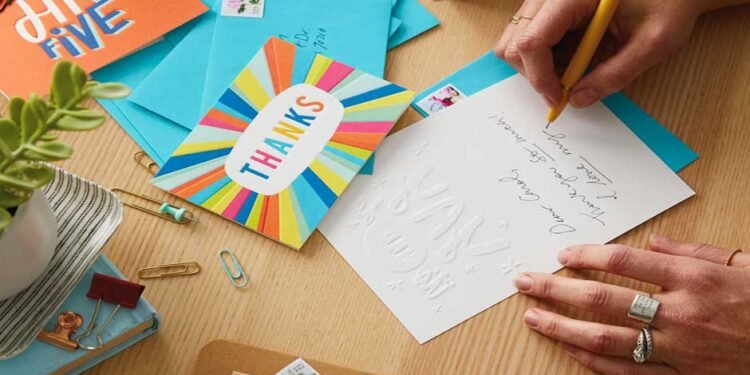In an age where digital communication dominates, the art of letter writing and sending handwritten cards has become even more special. Whether it’s for birthdays, holidays, or just to say hello, sending a personal letter or card can brighten someone’s day and create a meaningful connection. Here are some tips to help you write more letters and cards, making the process enjoyable and fulfilling.
Embrace the Value of Handwritten Notes
Understanding the importance and impact of handwritten notes can motivate you to write more. Handwritten letters and cards convey thoughtfulness, care, and a personal touch that electronic messages often lack. They show that you took the time and effort to connect with someone in a meaningful way.
a. Personal Touch
A handwritten note is a tangible piece of communication that can be kept and cherished for years. The recipient can see your handwriting, which adds a deeply personal touch that typed text cannot replicate. It conveys effort, care, and individuality, making the message feel more intimate and sincere.
b. Emotional Connection
Receiving a letter or card can evoke strong emotions and memories. It can make someone feel special, appreciated, and remembered, strengthening your bond with them. This emotional connection can be especially powerful during significant life events or challenging times, providing comfort and support.
Create a Writing Routine
Establishing a regular routine can help you write more consistently. Set aside specific times each week or month dedicated to writing letters and cards.
a. Schedule Time
Allocate a specific time in your calendar for writing. It could be a Sunday afternoon or a quiet evening during the week. Consistency is key to building a habit.
b. Create a Cozy Environment
Set up a comfortable and inviting space for writing. Gather your favorite stationery, pens, and maybe a cup of tea or coffee. Creating a pleasant atmosphere can make the task more enjoyable.
Keep a List of Recipients
Maintaining a list of people you want to write to can help you stay organized and ensure that no one is forgotten.
a. Special Occasions
Keep track of birthdays, anniversaries, and other special occasions. A calendar or planner can help you remember important dates.
b. Regular Correspondence
Include people you want to write to regularly, such as family members, friends, and pen pals. Regular correspondence can deepen your relationships over time.
Gather Quality Stationery
Investing in good-quality stationery can make the writing process more enjoyable and your letters more appealing, encouraging more frequent correspondence.
a. Choose Your Style
Select stationery that reflects your personal style and taste. This could be elegant letter paper with a refined design, fun and colorful cards that showcase your personality, or simple yet classy note cards for a timeless touch.
b. Variety
Keep a variety of stationery on hand for different occasions and recipients, including holiday-themed cards and professional letterhead. Having a diverse selection can inspire you to write more often and make each letter or card feel unique and special.
Start with Simple Messages
Start with simple messages if you’re new to letter writing or feeling overwhelmed. A short note or a quick card can be just as meaningful as a longer letter.
a. Short and Sweet
A brief message expressing your thoughts and well-wishes can go a long way. Focus on conveying your sincerity and warmth.
b. Gradual Progression
As you become more comfortable, you can gradually write longer and more detailed letters. Starting small helps build confidence and ease.
Stay Organized
Keeping your writing materials and recipient list organized can streamline the process.
a. Stationery Storage
Have a designated space for your stationery, pens, mailing address labels, envelopes, stamps, and other supplies. A tidy and easily accessible setup can make your writing sessions more efficient and enjoyable.
b. Address Book
Maintain an up-to-date address book, including phone numbers and email addresses. This ensures that you always have the necessary contact information readily at hand for any occasion.
Be Genuine and Sincere
Authenticity is key in letter writing. Write from the heart and be genuine in your expressions.
a. Personal Stories
Share personal anecdotes and experiences. This makes your letter more engaging and allows the recipient to feel closer to you.
b. Honest Emotions
Express your true feelings, whether they are of joy, gratitude, or concern. Authenticity creates a deeper connection.
Include Personal Touches
Adding personal touches can make your letters and cards even more special.
a. Photos and Mementos
Include small photos, drawings, or mementos that the recipient would appreciate. These additions make your correspondence more memorable.
b. Decorative Elements
Use stickers, washi tape, or doodles to decorate your letters and cards. Personalizing your stationery adds charm and creativity.
Address Writer’s Block
Everyone experiences writer’s block at times. Here are some strategies to overcome it.
a. Writing Prompts
Use writing prompts to spark ideas. Prompts can be questions about the recipient’s life, seasonal themes, or reflections on shared memories.
b. Free Writing
Allow yourself to write without worrying about structure or grammar. Free writing can help you overcome initial resistance and get your thoughts flowing.
Celebrate the Joy of Giving
Remember that writing letters and cards is an act of kindness and generosity. Embrace the joy it brings to both you and the recipient.
a. Positive Impact
Reflect on the positive impact your letters and cards can have. Knowing that you can brighten someone’s day can be a powerful motivator.
b. Gratitude
Express gratitude for the opportunity to connect with others through your letters. Writing can be a fulfilling and rewarding experience.
Conclusion
Writing more letters and cards is a wonderful way to foster connections, express your thoughts and emotions, and spread joy. By embracing the value of handwritten notes, creating a routine, staying organized, and being genuine and creative, you can make letter writing an enjoyable and fulfilling practice. Whether it’s a simple note or a detailed letter, each piece of correspondence carries the potential to brighten someone’s day and strengthen your relationships. So, pick up your pen, gather your favorite stationery, and start writing more letters and cards today.












